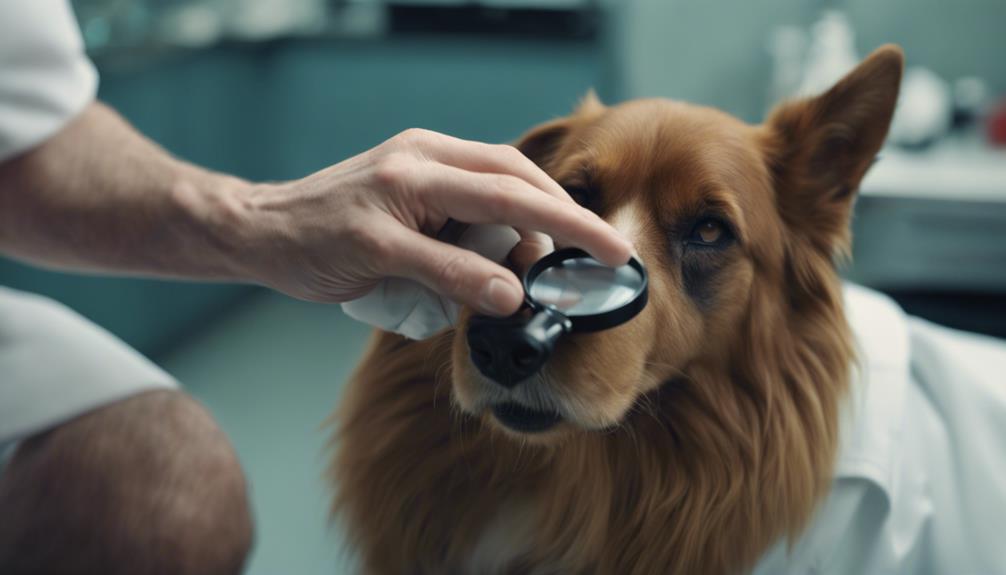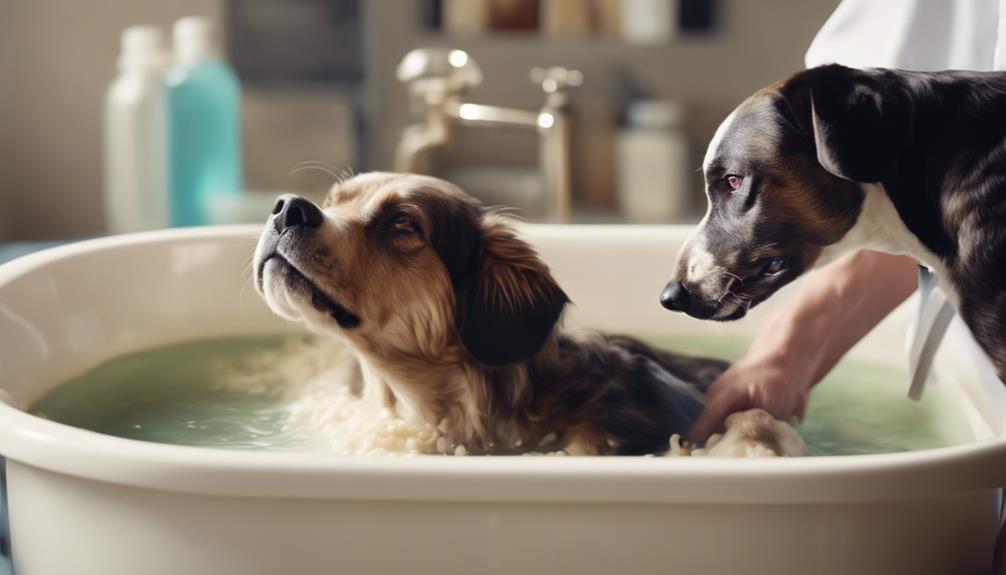Hot spots on dogs can be a troublesome skin condition for pet owners, often requiring prompt attention to prevent worsening. Understanding the underlying causes and symptoms of hot spots is essential in providing adequate care for our furry friends.
From diagnosis to treatment and prevention strategies, the comprehensive management of hot spots involves a multifaceted approach. By unraveling the complexities surrounding this dermatological issue, pet owners can equip themselves with the knowledge necessary to safeguard their dogs' skin health.
But what exactly are the key triggers that lead to the development of these irritating hot spots, and how can they be effectively managed to ensure the well-being of our beloved companions?
Key Takeaways
- Hot spots on dogs result from various irritations and require veterinary intervention.
- Symptoms include red, oozing sores, excessive licking, and rapid growth if untreated.
- Treatment involves cleaning, antibiotics, and e-collars to prevent licking.
- Prevention includes good skin care, dryness after baths, and year-round flea prevention.
What Are Hot Spots on Dogs?
Hot spots on dogs, also known as acute moist dermatitis, are inflammatory skin lesions that manifest as red, oozing sores prone to rapid spread if left untreated. These lesions are typically triggered by various skin irritations like insect bites, allergies, or trapped moisture. Hot spots worsen due to behaviors such as licking, scratching, and bacterial infections.
They are characterized by red, open sores that do not scab over and can lead to intense itching and discomfort for the dog. Signs of hot spots include obsessive scratching, licking, or biting in a localized area, which can quickly grow in size if not addressed promptly.
Any dog breed can be affected by hot spots, with higher prevalence in hot and humid weather conditions.
Understanding Hot Spot Triggers
Skin irritations triggered by various factors can lead to the development of hot spots on dogs. Hot spot triggers can vary, but common ones include:
- Allergies to food or environmental factors
- Insect bites or stings
- Excessive moisture or humidity in the coat
These triggers can cause dogs to lick, scratch, or bite at the affected area, leading to further irritation and the formation of hot spots.
Understanding these triggers is crucial in both preventing hot spots and addressing them promptly to avoid worsening of the condition. By identifying and addressing the underlying causes, pet owners can help their dogs avoid the discomfort and complications associated with hot spots.
Recognizing Hot Spot Symptoms

Early detection of specific signs can aid in promptly identifying potential hot spots on dogs. Signs of hot spots include red, oozing sores that do not scab over, along with obsessive scratching, licking, or biting. These behaviors can lead to rapid growth in the size of the affected area.
Additionally, hot spots may cause hair loss and inflammation in the affected area. Dog owners should pay attention to any changes in their pet's skin appearance, such as redness or moisture, as these could be early indicators of hot spots. Recognizing these symptoms early on can help in seeking timely veterinary intervention to prevent further complications and discomfort for the dog.
Importance of Veterinary Consultation
Seeking veterinary consultation is imperative when suspecting hot spots on your dog to ensure accurate diagnosis and appropriate treatment. Veterinarians are trained to identify the underlying causes of hot spots and provide tailored treatment plans to help your dog recover effectively. Professional guidance can also prevent potential complications and ensure the well-being of your pet.
- Specialized Expertise: Vets have the knowledge and experience to differentiate hot spots from other skin conditions accurately.
- Diagnostic Tools: Veterinary clinics are equipped with tools like skin cytology and bacterial cultures to pinpoint the exact cause of hot spots.
- Tailored Treatment Plans: Vets can recommend specific medications, shampoos, and dietary changes based on your dog's individual needs.
Diagnostic Procedures for Hot Spots

Veterinary professionals employ diagnostic procedures to accurately identify and analyze hot spots on dogs.
The diagnosis typically involves a thorough physical examination of the affected area to assess the size, extent, and severity of the hot spot. Skin scrapings may be performed to rule out underlying conditions such as mange or fungal infections.
Additionally, veterinarians may take samples from the hot spot for cytology to examine the cells under a microscope, helping to determine if there is a bacterial or yeast infection present. In some cases, further tests like allergy testing may be recommended to identify potential triggers for the hot spots.
Accurate diagnosis is essential for devising an effective treatment plan to alleviate the discomfort and promote healing in dogs with hot spots.
Long-Term Management of Hot Spots
Sustained management of hot spots in dogs requires consistent adherence to preventive measures and ongoing veterinary guidance. To ensure long-term control and prevention of hot spots, consider the following strategies:
- Regular grooming and maintenance of your dog's coat to prevent matting and moisture buildup.
- Implementing a balanced diet rich in essential nutrients to promote healthy skin and coat.
- Monitoring your dog for any signs of discomfort or skin irritation and seeking veterinary advice promptly.
These proactive measures, coupled with regular veterinary check-ups, can help minimize the occurrence and severity of hot spots in your canine companion, ensuring their skin health and overall well-being.
Treatment Options for Hot Spots

Implementing effective treatment strategies is crucial in addressing hot spots on dogs, aiming to alleviate discomfort and promote healing of the affected skin. Treatment options for hot spots often involve trimming the hair around the affected area to allow better airflow and cleaning.
Keeping the area clean and dry is essential to prevent further irritation and infection. Veterinarians may recommend using mild shampoos or sprays specifically designed for hot spots to help soothe the skin and reduce inflammation. Additionally, topical treatments such as hydrocortisone creams or sprays can help alleviate itching and discomfort.
It is important to follow the veterinarian's advice regarding medication, cleaning routines, and the use of e-collars to prevent licking and allow the hot spots to heal effectively.
Using Antibacterial Solutions
When addressing hot spots on dogs, incorporating antibacterial solutions is a crucial step in the treatment process to promote healing and prevent further infection. Antibacterial solutions help to eliminate harmful bacteria, reduce inflammation, and aid in the healing of hot spots. They are effective in preventing secondary infections and speeding up the recovery process.
When using antibacterial solutions, it is important to follow the veterinarian's instructions for proper application and dosage to ensure the best results for your dog's skin condition.
- Antibacterial solutions help eliminate harmful bacteria.
- Reducing inflammation in the affected area.
- Aiding in the healing process of hot spots.
E-Collars for Hot Spot Healing

In the context of treating hot spots on dogs, utilizing e-collars is a valuable measure to prevent excessive licking and facilitate proper healing of the affected areas. E-collars, also known as Elizabethan collars or cones, create a physical barrier that prevents the dog from reaching the hot spot, allowing it to heal without interference. These collars are particularly useful in cases where dogs persistently lick or chew at the irritated area, exacerbating the condition. By using e-collars, pet owners can effectively break the cycle of licking and scratching, promoting faster recovery.
| Pros | Cons |
|---|---|
| Prevents excessive licking | Can be uncomfortable for dogs |
| Facilitates proper healing | May cause stress or anxiety |
| Easy to use | Limits peripheral vision |
| Available in various sizes | Potential for obstruction |
Skin and Coat Health Maintenance
Maintaining optimal skin and coat health in dogs is essential for preventing and managing hot spots and other skin irritations.
Regular grooming sessions help distribute natural oils, keeping the skin moisturized and the coat shiny.
Providing a balanced diet rich in essential fatty acids supports skin health and improves coat condition.
Using dog-specific shampoos and conditioners tailored to your pet's skin type can help prevent dryness and irritation.
Preventing Excessive Licking Behavior

To prevent hot spots and other skin irritations in dogs, addressing excessive licking behavior is crucial for maintaining optimal skin and coat health. Excessive licking can lead to skin damage, introducing bacteria and causing inflammation, which in turn can exacerbate hot spots. There are several strategies to help prevent excessive licking behavior in dogs, such as using e-collars to physically deter licking. Additionally, providing mental stimulation, regular exercise, and addressing any underlying medical issues can also help reduce excessive licking. Below is a table outlining key methods for preventing excessive licking behavior in dogs:
| Prevention Methods | Description | Benefits |
|---|---|---|
| Use of e-collars | Physical barrier to prevent licking | Prevents self-inflicted harm |
| Mental stimulation | Engage dog's mind to reduce boredom | Reduces stress and anxiety |
| Regular exercise | Physical activity to promote well-being | Helps channel energy |
Importance of Proper Drying Techniques
Proper drying techniques play a crucial role in preventing skin irritations and promoting optimal skin and coat health in dogs. Ensuring thorough drying after baths or swims is essential to prevent moisture-related skin issues.
Here are three key reasons why proper drying techniques are important:
- Preventing bacterial growth: Damp fur provides an ideal environment for bacteria to thrive, leading to skin infections and hot spots.
- Maintaining skin integrity: Adequate drying helps prevent skin irritation and itching, reducing the likelihood of hot spots developing.
- Enhancing coat health: Properly dried coats are less prone to tangling and matting, promoting a healthy and lustrous appearance.
Year-Round Flea Prevention Strategies

Ensuring consistent flea prevention measures throughout the year is essential for safeguarding your dog's skin health and overall well-being. Fleas not only cause discomfort and irritation to dogs but can also lead to hot spots through their bites.
Utilizing year-round flea prevention strategies such as monthly topical treatments, oral medications, flea collars, or regular grooming with flea combs can help in keeping flea infestations at bay.
It's important to consult with your veterinarian to determine the most suitable flea prevention method for your dog based on their individual needs and lifestyle.
Safe Use of Coconut Oil for Dogs
Effective skin care for dogs includes considering safe options like coconut oil, which can offer various benefits when used appropriately. Coconut oil can be a natural and gentle way to help soothe and nourish your dog's skin, promoting overall skin health.
When using coconut oil for dogs, it is important to:
- Start with small amounts to test for any potential allergic reactions.
- Use virgin or organic coconut oil to ensure purity and quality.
- Apply topically by gently massaging into the skin or feeding in small amounts to take advantage of its potential benefits.
Recognizing Signs of Dog Ear Infections

An essential aspect of canine health care involves recognizing the signs indicative of potential ear infections in dogs. Symptoms of ear infections in dogs may include shaking of the head, scratching at the ears, redness or swelling of the ear canal, unusual odor or discharge from the ear, and sensitivity or pain when the ears are touched.
Dogs with ear infections may also show signs of hearing loss, balance issues, or tilting of the head. It is crucial to monitor any changes in your dog's behavior or ear health and seek veterinary attention promptly if you suspect an ear infection. Early detection and treatment of ear infections can help prevent complications and discomfort for your furry companion.
Conclusion
In conclusion, hot spots on dogs can be a distressing skin condition that requires prompt attention and proper management. Understanding the causes, symptoms, and preventive measures associated with hot spots is essential for maintaining the skin health of our canine companions.
By working closely with veterinarians, implementing preventive strategies, and using appropriate treatments, dog owners can effectively address hot spots and ensure the well-being of their beloved pets.




